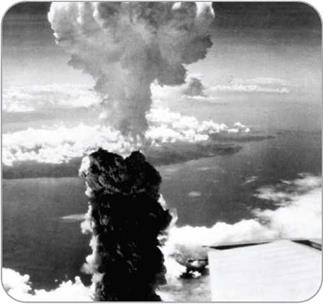New Bombing Developments
In May 1942, RAF Bomber Command launched its first “1,000-bomber” raid, targeting the German city of Cologne. Bombs were unguided, but aim was more accurate, thanks to the U. S.-
|
O On August 9, 1945, two U. S. planes flew over Nagasaki, Japan, to drop the second atomic bomb used in World War II. No atomic bombs have been used in warfare since. |
designed Norden bombsight. This device had a gyroscopically stabilized telescope for the bombardier to sight the target during the bombing run. The bombsight computer automatically made course corrections to ensure that the bombs were released over their targets.
The weight of bombs increased. In 1943, the first 12,000-pound (5,440- kilogram) bomb was used. The first 22,000-pound (9,990-kilogram) “grand slam” bomb followed in 1944. The size of airplanes also grew. The B-29 of 1944 was twice as heavy as the earlier British Lancaster. The B-29 could cruise at
30,0 feet (9,140 meters) during a mission that might last 15 hours, driving off enemy fighters with thirteen defensive guns controlled by a computer system.
The most destructive weapons in history were the two atomic bombs dropped by B-29s on the Japanese cities of Hiroshima and Nagasaki (August 1945). The bombs destroyed the cities and killed an estimated 200,000 people.











